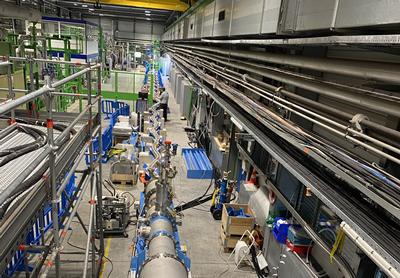University expertise to help power the latest upgrade of Large Hadron Collider

The University of Southampton is to play a major role in an upgrade of the Large Hadron Collider announced by the Science and Technologies Facilities Council (STFC).
Experts from the University’s School of Engineering will develop the technology required to cold power the superconducting magnets that guide high-energy particle beams around the 27 Kilometre tunnel.
There are many new types of magnet going into the LHC for the upgrade. The current LHC uses magnets that are around eight Tesla and the new magnets will be as high as 11 Tesla.
These new types of magnet need to be powered and the power going through the transmission lines needs to deliver additional current of more than 100,000 amperes. Such high currents are carried by superconducting cables with negligible electrical resistance to power the magnets.
The power is generated over 100 meters away from the magnets in the tunnel in order to protect the power supplies from the increased radiation of the beams at a higher intensity. To enable effective cooling over such distance to a 20 meter elevation, a new type of transmission line using high temperature superconductors operating in helium gas has to be developed.
These new superconducting cables then need to be connected to the superconducting magnets operating in liquid helium at four kelvin (minus 271 degrees Celsius). Connecting the two types of conductors requires a very carefully designed intersection device which must also control the flow of helium gas to cool the new superconducting cable over complex 100 metre long paths.
Yifeng Yang, Professor of Cryogenics and Applied Superconductivity at the University of Southampton said:
“Since the inception of the LHC, University of Southampton has been a long-term partner of CERN in developing innovative approaches for the cold powering of superconducting magnets. For the LHC upgrade, we have carried out initial proof of concept tests of the new superconducting cables and devised the baseline strategy for cooling and controlling them.”
In phase one, the University of Southampton developed a prototype multifunctional cryostat as the interfacing and control centre for the new cold powering system. Within phase two, they will be delivering a total of nine of the intersection/distribution/control boxes to be installed at the LHC.
The University has been awarded £2.1M from STFC as part of the HL-LHC-UK Phase 2 Project. This has been matched with cash and in-kind funding from CERN to fund the development and manufacture of these cryomodules.
The HL-LHC-UK Phase 2 project is a collaboration between the Science and Technology Facilities Council (STFC), CERN, the Cockcroft Institute, the John Adams Institute, and eight UK Universities.
The universities involved in the consortium are the University of Dundee, University of Huddersfield, Lancaster University, University of Liverpool, University of Manchester, University of Oxford, University of Royal Holloway and the University of Southampton.
Further information on the upgrade is available on the STFC website.